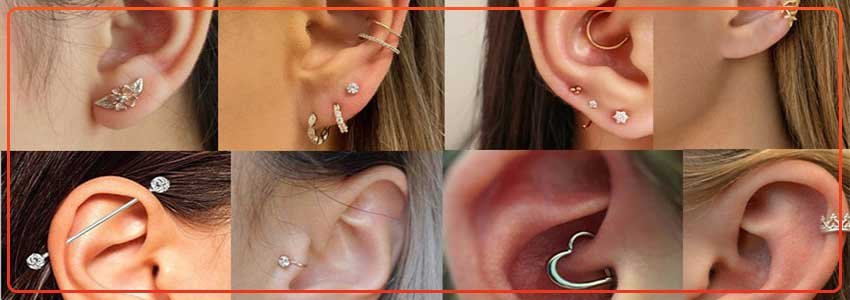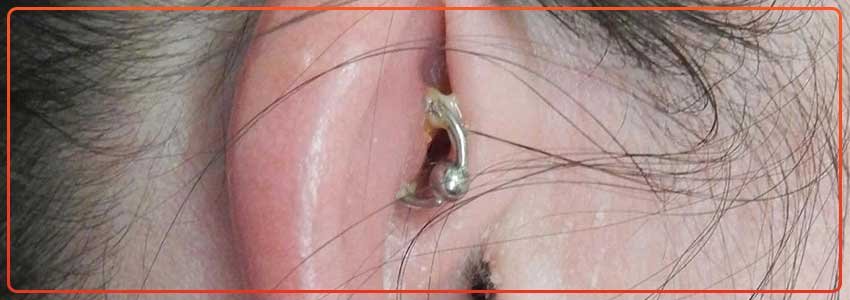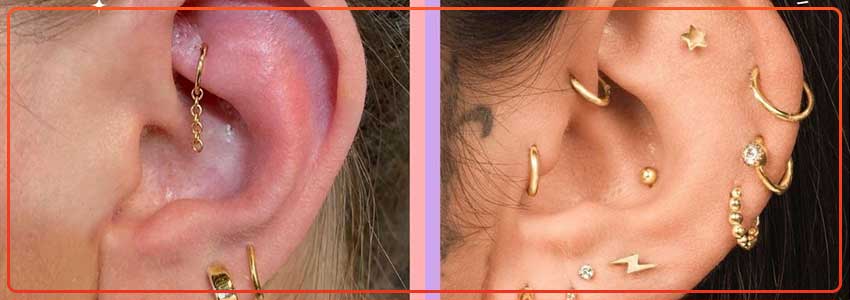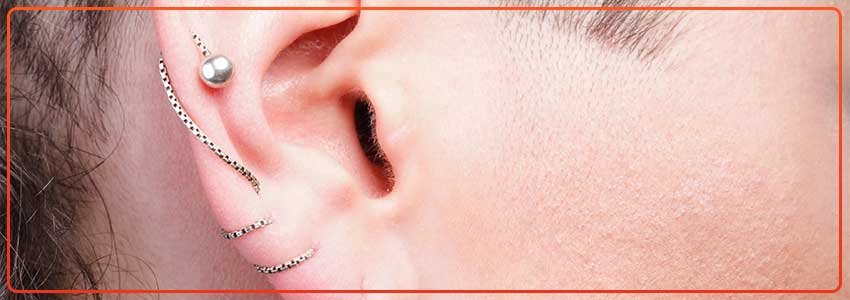Ear piercings have become increasingly popular in recent years, with people of all ages and backgrounds sporting a variety of different styles and types. Whether it’s a simple single lobe piercing or a more complex industrial piercing, ear piercings are a way to express one’s personality and individuality. However, with so many different types of ear piercings to choose from, it can be overwhelming to know which one is right for you.
That’s why it’s important to have a good understanding of the different types of ear piercings that are available. Knowing the differences between each type can help you make an informed decision about what kind of piercing will suit your personal style and lifestyle. Additionally, understanding the aftercare and healing process for each type of piercing can help you avoid any potential complications or infections that may arise. So, let’s take a closer look at the different types of ear piercings available and why it’s important to know about them.
Types of ear piercings for the earlobe
When it comes to ear piercings, the earlobe is often the most popular area to pierce. From simple single piercings to more complex and layered styles, the options are endless. Whether you’re looking for a subtle and classic look or something more dramatic and unique, there’s an earlobe piercing style to suit everyone.
In this section, we’ll explore the most popular types of earlobe piercings, including single, double, and triple lobe piercings, as well as more complex styles like the orbital and industrial piercings.
Single Lobe Piercing
This is the most common type of ear piercing and involves making a single hole in the center of the earlobe. It’s a simple and quick procedure, and healing time is usually around 4-6 weeks. This type of piercing is suitable for anyone who wants a subtle and classic look.
Double Lobe Piercing
As the name suggests, this type of piercing involves making two holes in the earlobe, typically spaced apart. It’s a popular choice for those who want a slightly more edgy or trendy look. Healing time is similar to a single lobe piercing, around 4-6 weeks.
Triple Lobe Piercing
For those who want even more earlobe piercings, the triple lobe piercing involves making three holes in the earlobe. This creates a stacked effect and is ideal for those who want to create a more unique and interesting look. Healing time is slightly longer than for single or double lobe piercings, around 6-8 weeks.
Orbital Piercing
This type of piercing involves making a hole in the earlobe and another hole further up the ear, with a piece of jewelry connecting the two holes. This creates a ring-like effect and is ideal for those who want a more unusual and eye-catching look. Healing time is around 6-8 weeks.
Industrial Piercing
This type of piercing involves making two holes in the upper ear and connecting them with a long piece of jewelry. It’s a more complex and involved procedure, and healing time can be up to 12 weeks. This type of piercing is best suited to those who want a more dramatic and statement-making look.
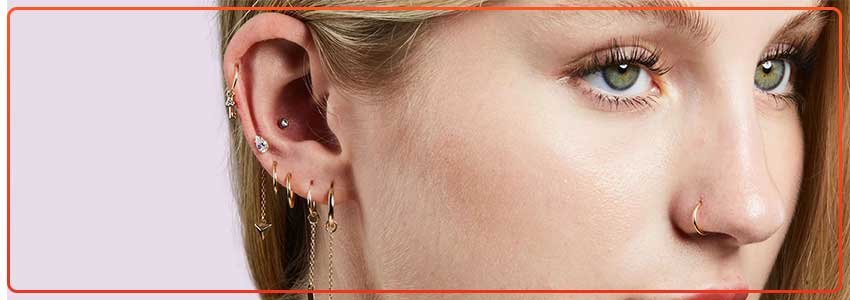
Types of Ear Piercings For The Cartilage
When it comes to ear piercings, cartilage piercings are a popular choice for those looking to create a more unique and edgy look. From the classic helix piercing to the more unusual rook or daith piercings, there are plenty of options for those who want to experiment with cartilage piercings. In this section, we’ll explore the most popular types of cartilage piercings, including helix, tragus, anti-tragus, rook, daith, and snug piercings, along with some information on healing times and aftercare tips.
Helix piercing: This is the most common type of cartilage piercing and involves making a hole in the upper rim of the ear. This type of piercing can be customized with various types of jewelry, such as studs or hoops, and is suitable for those who want a slightly more adventurous and unique look. Healing time is typically around 3-9 months.
Tragus Piercing
This type of piercing involves making a hole in the small piece of cartilage that protrudes from the ear just in front of the ear canal. It’s a popular choice for those who want a more subtle and delicate look. Healing time is usually around 3-9 months.
Anti-Tragus Piercing
The anti-tragus piercing involves making a hole in the small piece of cartilage opposite the tragus on the outer ear. This piercing is best suited for those who want to create a more unique and edgy look. Healing time is typically around 3-9 months.
Rook Piercing
The rook piercing involves making a hole in the fold of cartilage above the tragus. This type of piercing is less common than others, making it a great choice for those who want a more unusual and eye-catching look. Healing time is typically around 3-9 months.
Daith Piercing
This type of piercing involves making a hole in the innermost cartilage fold of the ear. It’s a popular choice for those who want a more discreet piercing as it is less visible from the outside. Some people also believe that this piercing can help alleviate migraines. Healing time is typically around 3-9 months.
Snug Piercing
The snug piercing involves making a hole in the inner cartilage fold of the ear, just above the anti-tragus. It’s a more unique and bold piercing choice, making it perfect for those who want to make a statement. Healing time is typically around 3-9 months.
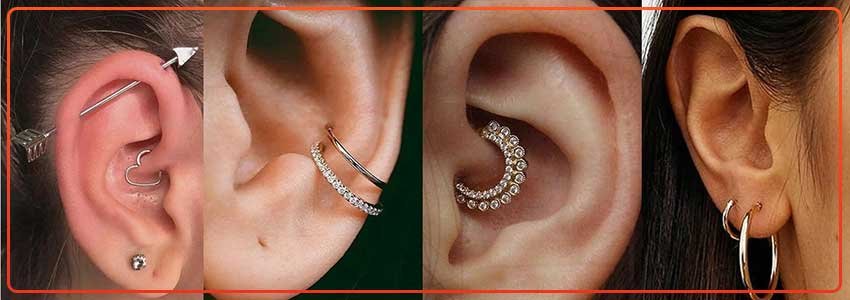
Uncommon types of ear piercings
While earlobe and cartilage piercings are quite common, there are also some more unusual types of ear piercings that can create a truly unique look. In this section, we’ll explore some of the less common ear piercings, including the conch piercing, flat piercing, transverse lobe piercing, and surface tragus piercing.
These piercings can be a great way to express your individuality and personal style, but they also require special care and attention to ensure proper healing. In this section, we’ll provide some information on each type of piercing, along with tips for aftercare and healing.
Conch Piercing
This type of piercing involves making a hole in the inner shell of the ear. It can be done in the upper or lower part of the ear and can be customized with various types of jewelry, such as hoops or studs. Healing time is typically around 3-9 months.
Flat Piercing
The flat piercing, also known as the helix flat piercing, involves making a hole in the flat area of cartilage above the ear lobe. This type of piercing is less common than others, making it a great choice for those who want a more unique and eye-catching look. Healing time is typically around 3-9 months.
Transverse Lobe Piercing
This type of piercing involves making a horizontal hole through the earlobe, rather than the more common vertical piercing. It’s a unique and bold piercing choice, making it perfect for those who want to make a statement. Healing time is typically around 2-4 months.
Surface Tragus Piercing
The surface tragus piercing involves making a hole in the skin just above the tragus, rather than the cartilage itself. This type of piercing is less common and can be more difficult to heal, but it can create a unique and eye-catching look. Healing time is typically around 3-9 months.
It’s important to note that while these piercings may be less common, they still require proper aftercare and attention to ensure proper healing. As with any piercing, it’s recommended to consult with a professional piercer to ensure that the piercing is done safely and correctly.
Aftercare For Ear Piercings
After getting a new ear piercing, proper aftercare is essential to ensure that the piercing heals properly and to prevent infection.
Here are some general tips for ear piercing aftercare:
- Keep the piercing clean: Use a saline solution or specialized piercing cleaner to gently clean the piercing twice a day. Avoid touching the piercing with dirty hands or other objects.
- Avoid irritants: Avoid swimming, hot tubs, and saunas for the first few weeks after getting a piercing. Also, avoid using hair products, makeup, or perfumes on or around the piercing.
- Don’t remove the jewelry: It’s important to keep the jewelry in the piercing until the piercing is fully healed. Removing the jewelry can cause the piercing to close or become infected.
Be patient: Healing time for ear piercings can vary depending on the type of piercing and your body’s healing process. It’s important to be patient and not rush the healing process.
Cleaning solutions for different types of piercings
In addition to these general tips, different types of ear piercings may require different cleaning solutions or aftercare procedures.
Here are some tips for cleaning different types of ear piercings:
Earlobe piercings
Earlobe piercings are the most common type of ear piercing and are relatively easy to care for. Here are some specific tips for aftercare:
- Clean the piercing twice a day with a saline solution or specialized piercing cleaner. Use a cotton ball or swab to apply the solution to the piercing and let it sit for a few minutes before rinsing with warm water.
- Avoid using alcohol, hydrogen peroxide, or other harsh cleaning solutions as they can damage the skin and slow down the healing process.
- Rotate the earring gently during cleaning to prevent the piercing from sticking to the skin.
Cartilage piercings
Cartilage piercings are more complex than earlobe piercings and require a bit more care. Here are some specific tips for aftercare:
- Use a saline solution or specialized piercing cleaner to clean the piercing twice a day. Be careful not to use too much pressure, as this can damage the cartilage.
- Avoid sleeping on the side of the piercing until it has fully healed.
- Use a clean pillowcase and avoid touching the piercing unnecessarily.
Uncommon piercings
Uncommon ear piercings, such as daith or rook piercings, may require more specific aftercare instructions. Here are some general tips to follow:
- Follow the aftercare instructions provided by your piercer, as each type of piercing may require unique aftercare methods.
- Be gentle when cleaning the piercing, and avoid using harsh cleaning solutions or rotating the earring too much.
- Avoid sleeping on the side of the piercing until it has fully healed, and be careful not to snag the earring on clothing or hair.
Overall, it’s essential to follow proper aftercare instructions to ensure that your ear piercing heals correctly and without complications. If you experience any issues or are unsure about how to care for your piercing, be sure to consult with a professional piercer or healthcare provider.
Conclusion
In conclusion, knowing about different types of ear piercings is important to ensure that you can choose the right piercing for you and care for it properly. Earlobe piercings are the most common type of ear piercing and are relatively easy to care for, while cartilage piercings require more specialized care to prevent complications. Uncommon piercings, such as daith or rook piercings, require unique aftercare methods that should be followed closely.
If you’re considering getting an ear piercing, it’s important to do your research and choose a reputable piercer who uses sterile equipment and follows proper safety procedures. You should also be prepared for some discomfort during the piercing process and take steps to care for your piercing properly afterward.
Remember that everyone’s body is different, and what works for one person may not work for another. If you experience any issues with your piercing, such as excessive redness, swelling, or discharge, it’s best to consult a healthcare professional.
In summary, ear piercings can be a fun and stylish way to express yourself, but it’s essential to choose the right piercing for you and care for it properly to prevent complications and ensure proper healing. With proper aftercare, your ear piercing can be a beautiful addition to your look.
FAQS
Q: What are the different types of ear piercings?
A: There are several types of ear piercings, including earlobe piercings, cartilage piercings, industrial piercings, daith piercings, rook piercings, and tragus piercings.
Q: What is an earlobe piercing?
A: An earlobe piercing is a common type of ear piercing that involves making a small hole through the fleshy part of the earlobe.
Q: What is a cartilage piercing?
A: A cartilage piercing involves making a hole through the cartilage of the ear, which is stiffer and more fibrous than the earlobe.
Q: What is an industrial piercing?
A: An industrial piercing involves two holes through the upper cartilage of the ear, which are connected by a single piece of jewelry.
Q: What is a daith piercing?
A: A daith piercing involves making a hole through the innermost fold of cartilage in the ear, which is located above the ear canal.
Q: What is a rook piercing?
A: A rook piercing involves making a hole through the antihelix fold of cartilage in the ear, which is located above the tragus and below the daith.
Q: What is a tragus piercing?
A: A tragus piercing involves making a hole through the small, thick piece of cartilage that extends over the ear canal.
Q: What is a helix piercing?
A: A helix piercing is a type of cartilage piercing done on the outer rim of the ear. It can be done in various locations along the rim, such as the upper helix, middle helix, or forward helix.
Q: What is a conch piercing?
A: A conch piercing is a type of cartilage piercing done on the innermost part of the ear, in the center of the flat portion of the ear cartilage. It can be done as a single piercing or as a double piercing, with one on the inner conch and one on the outer conch.
Q: What are the most common types of ear piercings?
A: The most common types of ear piercings include the lobe piercing, which is the standard piercing on the earlobe, and the cartilage piercing, which can be done on various parts of the ear, such as the helix, tragus, and conch.
